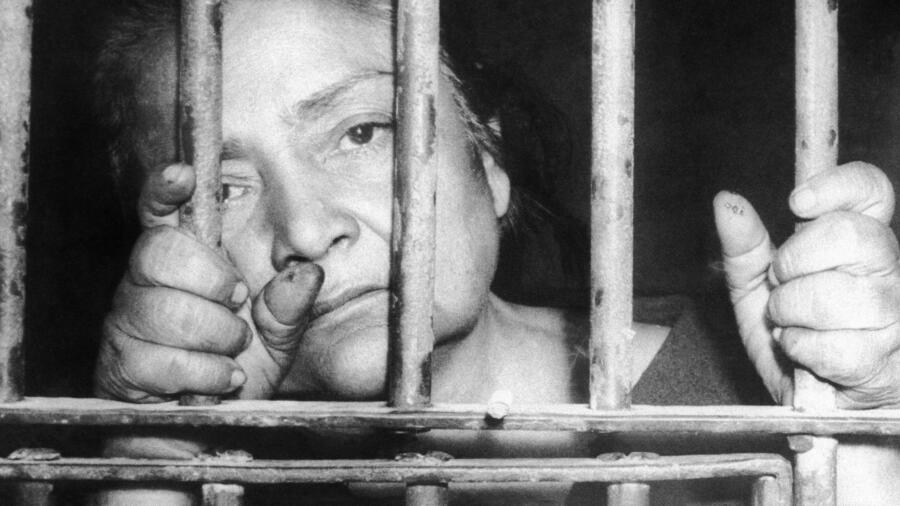For the many male serial killers you can no doubt name off the top of your head—Jeffrey Dahmer, John Wayne Gacy, Ted Bundy, Jack the Ripper—there are likely far fewer females of the genre that come to mind.
You may recall Aileen Wuornos, who killed at least six men in Florida and was executed in 2002. Or perhaps you’ve heard of Mary Ann “Dark Angel” Cotton, a British woman in the mid-1800s whose husbands and family members had a bad habit of passing away from stomach trouble. She was convicted of killing her 7-year-old stepson and was thought to have murdered as many as 20 others—probably by arsenic poisoning. She was executed by hanging in 1873.
And maybe you read here about Belle Gunness, the early-20th century widow known for the dozen or more potential suitors she lured and murdered on her Indiana pig farm. After a suspicious fire, she was never seen again—but a dozen bodies were discovered on her property.
Why are there—as far as we know—fewer female serial killers? Because serial killers, in general, are a rare and unusual breed, says Christina DeJong associate professor in the School of Criminal Justice at Michigan State University and vice-president of the American Society of Criminology. “The average person probably thinks that serial killers are more common than they really are.”
DeJong also credits the theories of nature and nurture as reasons there seem to be less female serial killers: Men are generally physically larger and stronger than women and women are often raised to be less aggressive and less physical than men.
“Women are less likely to be involved in violent crime overall, if you look at rates of assault and rates of homicide,” says DeJong.
Is there anything that links the women of the genre? “Criminologists are trained to look at hundreds and hundreds of cases and see the patterns,” says DeJong, “but the sample size here is so small that we end up having to generalize.” That means when it comes to the even less common female serial killer—the black widow, the Victorian poisoner, the deranged and codependent girlfriend—it’s that much harder to untangle the underlying motivations.
Even for those who have become household names, it’s hard to group them because “they’re so individual and so dependent on the circumstances of their own situation,” says DeJong. “All you can do is do look at case studies of individuals and analyze them in depth, which is why everyone knows Aileen Wuornos’s name—there’s nobody else like her.”
…Or is there? We found four female serial killers from history whose mesmerizing stories seem to have been virtually forgotten today.
Amelia Elizabeth Dyer
The Ogress of Reading
She was what was known in Victorian England as a “baby farmer.” Dyer charged a fee to take in unmarried women who couldn’t hide their pregnancies. Because of social mores, these single moms were unable to work (except as prostitutes) and, due to the laws of the time, had little recourse for demanding financial support from the fathers. Dyer supposedly fostered these infants for a weekly fee, saving money by slowly starving them.
After being imprisoned briefly for infant neglect, she changed her methods—accepting a one-time fee to adopt babies. She was thought to have quickly strangled them and dumped them in the river or buried them in her garden.
After one of the most sensational trials of the era, Dyer was convicted of the murder of a baby found in the Thames. (She is said to have told the police dragging the river for bodies, “You’ll know all mine by the tape around their necks.”) Police estimated that, over her 30-year career, she could have had some 300 or more tiny victims. She was executed by hanging at Newgate Prison on June 10, 1896.
Delfina and María de Jesús Gonzàlez Valenzuela
The Mexican Bordello From Hell
The Guinness Book of World Records dubbed them the “most prolific murder partnership.” In the 1950s and ’60s, Delfina and Maria Gonzàlez Valenzuela ran a brothel called Rancho El Angel in the state of Guanajuato, north of Mexico City. They were said to have recruited young women as maids via help-wanted ads and then forced the applicants into prostitution. If the women rebelled or became ill, the sisters starved, beat, and/or killed them.
The pair also were said to have killed patrons who showed up with lots of cash.
In 1964, the two sisters were convicted of having killed at least 80 girls, each receiving a maximum 40-year prison sentence; 19 other members of the slave ring, including other family members, were reportedly also given jail sentences.
Enriqueta Martí
The Vampire of Barcelona
At the beginning of the 20th century, in the red-light district of Barcelona, Enriqueta Martí, a domestic-turned-“healer” was said to have made “cures” for incurable diseases such as tuberculosis. She fashioned her various elixirs and potions from the skin, fat and bone marrow of children she abducted.
In 1912, police reportedly found two of the missing children at Martí’s home, plus body parts from some 30 others. The alleged killer never stood trial for her crimes. In 1913, she was reportedly beaten to death in prison by other inmates.
Related Features:
What Really Happened to Belle Gunness, Serial Killer and Butcher of Men?


